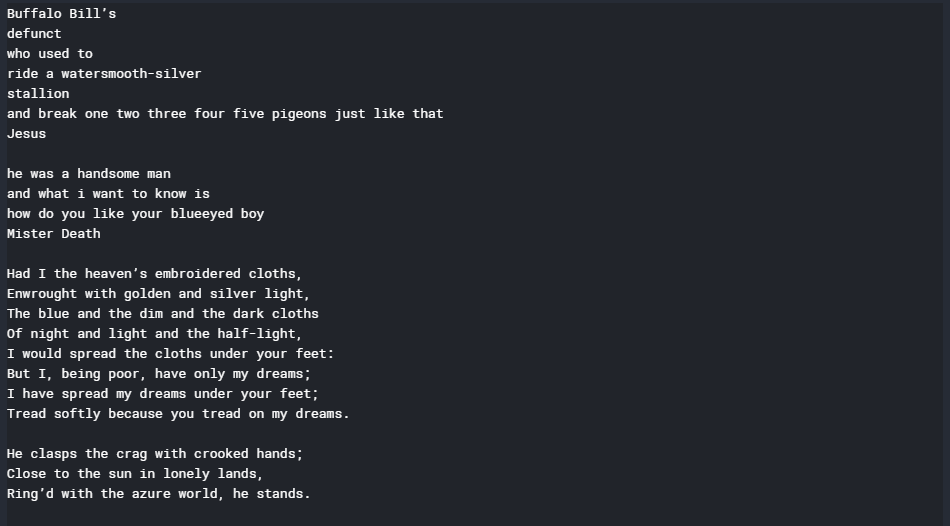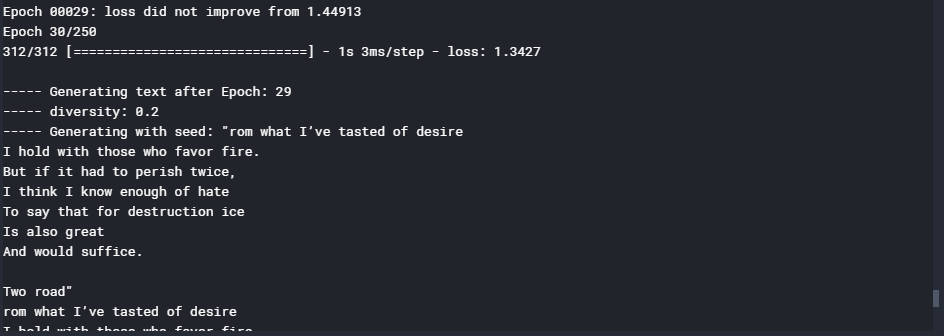本文将演示如何构建一个文字产生器通过建立一个门控循环单元网络。训练网络的概念性过程是首先向网络提供网络上正在训练的文本中存在的每个字符到唯一编号的映射。然后将每个字符热编码为向量, 这是网络所需的格式。
所描述过程的数据是著名诗人的简短和著名诗集, 并且是.txt格式。可以从以下位置下载这里.
步骤1:导入所需的库
from __future__ import absolute_import, division, print_function, unicode_literals
import numpy as np
import tensorflow as tf
from keras.models import Sequential
from keras.layers import Dense, Activation
from keras.layers import LSTM
from keras.optimizers import RMSprop
from keras.callbacks import LambdaCallback
from keras.callbacks import ModelCheckpoint
from keras.callbacks import ReduceLROnPlateau
import random
import sys步骤2:将数据加载到字符串中
# Changing the working location to the location of the text file
cd C:\Users\Dev\Desktop\Kaggle\Poems
# Reading the text file into a string
with open ( 'poems.txt' , 'r' ) as file :
text = file .read()
# A preview of the text file
print (text)
步骤3:创建从文本中每个唯一字符到唯一数字的映射
# Storing all the unique characters present in the text
vocabulary = sorted ( list ( set (text)))
# Creating dictionaries to map each character to an index
char_to_indices = dict ((c, i) for i, c in enumerate (vocabulary))
indices_to_char = dict ((i, c) for i, c in enumerate (vocabulary))
print (vocabulary)
步骤4:预处理数据
# Dividing the text into subsequences of length max_length
# So that at each time step the next max_length characters
# are fed into the network
max_length = 100
steps = 5
sentences = []
next_chars = []
for i in range ( 0 , len (text) - max_length, steps):
sentences.append(text[i: i + max_length])
next_chars.append(text[i + max_length])
# Hot encoding each character into a boolean vector
# Initializing a matrix of boolean vectors with each column representing
# the hot encoded representation of the character
X = np.zeros(( len (sentences), max_length, len (vocabulary)), dtype = np. bool )
y = np.zeros(( len (sentences), len (vocabulary)), dtype = np. bool )
# Placing the value 1 at the appropriate position for each vector
# to complete the hot-encoding process
for i, sentence in enumerate (sentences):
for t, char in enumerate (sentence):
X[i, t, char_to_indices[char]] = 1
y[i, char_to_indices[next_chars[i]]] = 1步骤5:建立GRU网络
# Initializing the LSTM network
model = Sequential()
# Defining the cell type
model.add(GRU( 128 , input_shape = (max_length, len (vocabulary))))
# Defining the densely connected Neural Network layer
model.add(Dense( len (vocabulary)))
# Defining the activation function for the cell
model.add(Activation( 'softmax' ))
# Defining the optimizing function
optimizer = RMSprop(lr = 0.01 )
# Configuring the model for training
model. compile (loss = 'categorical_crossentropy' , optimizer = optimizer)步骤6:定义一些在网络训练期间将使用的辅助功能
请注意, 下面给出的前两个功能已从Keras团队的官方文本生成示例.
a)辅助函数采样下一个字符:
# Helper function to sample an index from a probability array
def sample_index(preds, temperature = 1.0 ):
# temperature determines the freedom the function has when generating text
# Converting the predictions vector into a numpy array
preds = np.asarray(preds).astype( 'float64' )
# Normalizing the predicitons array
preds = np.log(preds) /temperature
exp_preds = np.exp(preds)
preds = exp_preds /np. sum (exp_preds)
# The main sampling step. Creates an array of probablities signifying
# the probability of each character to be the next character in the
# generated text
probas = np.random.multinomial( 1 , preds, 1 )
# Returning the character with maximum probability to be the next character
# in the generated text
return np.argmax(probas)b)辅助功能在每个时期后生成文本
# Helper function to generate text after the end of each epoch
def on_epoch_end(epoch, logs):
print ()
print ( '----- Generating text after Epoch: % d' % epoch)
# Choosing a random starting index for the text generation
start_index = random.randint( 0 , len (text) - max_length - 1 )
# Sampling for different values of diversity
for diversity in [ 0.2 , 0.5 , 1.0 , 1.2 ]:
print ( '----- diversity:' , diversity)
generated = ''
# Seed sentence
sentence = text[start_index: start_index + max_length]
generated + = sentence
print ( '----- Generating with seed: "' + sentence + '"' )
sys.stdout.write(generated)
for i in range ( 400 ):
# Initializing the predicitons vector
x_pred = np.zeros(( 1 , max_length, len (vocabulary)))
for t, char in enumerate (sentence):
x_pred[ 0 , t, char_to_indices[char]] = 1.
# Making the predictions for the next character
preds = model.predict(x_pred, verbose = 0 )[ 0 ]
# Getting the index of the most probable next character
next_index = sample_index(preds, diversity)
# Getting the most probable next character using the mapping built
next_char = indices_to_char[next_index]
# Building the generated text
generated + = next_char
sentence = sentence[ 1 :] + next_char
sys.stdout.write(next_char)
sys.stdout.flush()
print ()
# Defining a custom callback function to
# describe the internal states of the network
print_callback = LambdaCallback(on_epoch_end = on_epoch_end)c)辅助功能可在损失减少的每个时期之后保存模型
# Defining a helper function to save the model after each epoch
# in which the loss decreases
filepath = "weights.hdf5"
checkpoint = ModelCheckpoint(filepath, monitor = 'loss' , verbose = 1 , save_best_only = True , mode = 'min' )d)辅助功能可降低每次学习平台的学习速度
# Defining a helper function to reduce the learning rate each time
# the learning plateaus
reduce_alpha = ReduceLROnPlateau(monitor = 'loss' , factor = 0.2 , patience = 1 , min_lr = 0.001 )
callbacks = [print_callback, checkpoint, reduce_alpha]步骤7:训练GRU模型
# Training the GRU model
model.fit(X, y, batch_size = 128 , epochs = 30 , callbacks = callbacks)
步骤8:产生新的随机文字
def generate_text(length, diversity):
# Get random starting text
start_index = random.randint( 0 , len (text) - max_length - 1 )
# Defining the generated text
generated = ''
sentence = text[start_index: start_index + max_length]
generated + = sentence
# Generating new text of given length
for i in range (length):
# Initializing the predicition vector
x_pred = np.zeros(( 1 , max_length, len (vocabulary)))
for t, char in enumerate (sentence):
x_pred[ 0 , t, char_to_indices[char]] = 1.
# Making the predicitons
preds = model.predict(x_pred, verbose = 0 )[ 0 ]
# Getting the index of the next most probable index
next_index = sample_index(preds, diversity)
# Getting the most probable next character using the mapping built
next_char = indices_to_char[next_index]
# Generating new text
generated + = next_char
sentence = sentence[ 1 :] + next_char
return generated
print (generate_text( 500 , 0.2 ))
注意:尽管现在输出的意义不大, 但可以通过训练模型更多的时期来显着改善输出。
首先, 你的面试准备可通过以下方式增强你的数据结构概念:Python DS课程。

